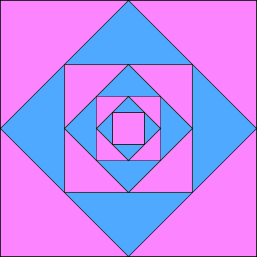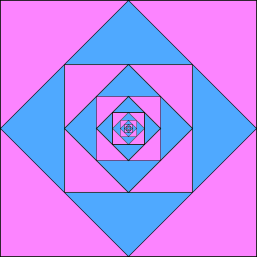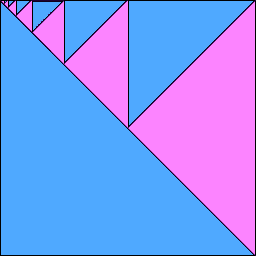Or search by topic
Number and algebra
Geometry and measure
Probability and statistics
Working mathematically
Advanced mathematics
For younger learners
Diminishing Returns



Diminishing Returns printable sheet
Take a look at the image below:

What can you see?
How do you think the pattern was made?
How do you think the pattern would continue?
What proportion of the total area of the square is taken up by the small square in the middle?
How do you know?
You might like to make a copy of the pattern for yourself using coloured paper. Or you could click below to show the different stages of construction of the image.
Imagine continuing the pattern towards the centre of the square:

If this process could be continued forever, what proportion of the image would be coloured blue?
Try to provide a convincing explanation that your answer is right.
Below is a collection of images created using repeating processes.
Choose a few of the images below, and work out what fraction of the total is taken up by the five largest blue shapes.
Add your fractions to estimate the proportion of the total that is coloured blue.
If each process could be continued for ever, what proportion of the whole image would be coloured blue?
Try to provide convincing explanations that your answers are right.



You may wish to take a look at Vanishing Point after working on this problem.
You may also like
Tweedle Dum and Tweedle Dee
Two brothers were left some money, amounting to an exact number of pounds, to divide between them. DEE undertook the division. "But your heap is larger than mine!" cried DUM...
Sum Equals Product
The sum of the numbers 4 and 1 [1/3] is the same as the product of 4 and 1 [1/3]; that is to say 4 + 1 [1/3] = 4 � 1 [1/3]. What other numbers have the sum equal to the product and can this be so for any whole numbers?
Special Sums and Products
Find some examples of pairs of numbers such that their sum is a factor of their product. eg. 4 + 12 = 16 and 4 × 12 = 48 and 16 is a factor of 48.

